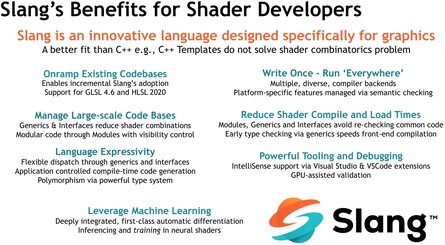HLSL and GLSL fulfill their task less and less, so it is necessary to innovate from this point of view as well.
The issue of shader languages is becoming more and more pressing these days, because currently the most widely supported graphics APIs accept shaders written in some versions of HLSL or GLSL. Of course, the newer, explicit APIs are no longer directly, but through some intermediate language, but the essence does not change, so a good number of shaders are written in HLSL or GLSL.
Hirdetés
However, it is a problem that, for example, the development of GLSL has stalled, so real innovation is no longer included, while HLSL is being innovated by Microsoft, but relatively slowly, and as a result, several planned functions arrive with longer delays. In fact, the basic problem is that both HLSL and GLSL were fundamentally designed to write small code of a few dozen lines, whereas today these languages are used for very large code of thousands of lines. It is technically feasible, but the situation is far from optimal.
However, there is a lesser-known language called Slang, which was born from a collaboration between NVIDIA, Carnegie Mellon University, Stanford University, MIT, the University of California San Diego (UCSD), and the University of Washington. It was specifically developed for complex shader programs, i.e. it is optimal for thousands of lines of code, while being compatible with almost all common APIs targeting GPUs.
The Khronos Group has just announced the Slang Initiative, which aims to spread the Slang language designed for modern needs and its translator. This open source initiative has many advantages, including the fact that the Slang compiler itself accepts not only Slang, but also HLSL 2020 and GLSL 4.6 with minor modifications, while generating optimal code for each of the other languages they target the individual APIs and interfaces. The latter include, for example, Vulkan, DirectX 12, Metal, WebGPU, and OpenGL.
The initiative is already supported by Valve and Autodesk, and there is basically no great objection to its application, as it can be well integrated into current software environments.
Source: prohardver.hu




